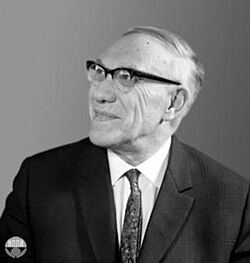Mikhail Lavrentyev facts for kids
Quick facts for kids
Mikhail Lavrentyev
|
|
|---|---|
| Михаил Лаврентьев | |
 |
|
| Born |
Mikhail Alekseyevich Lavrentyev
November 19, 1900 |
| Died | October 15, 1980 (aged 79) |
| Nationality | Soviet |
| Alma mater | Moscow State University |
| Awards | Lomonosov Gold Medal (1977) |
| Scientific career | |
| Fields | Mathematics |
| Institutions | Moscow State University Steklov Institute of Mathematics |
| Doctoral advisor | Nikolai Luzin |
| Doctoral students | Mstislav Keldysh Aleksei Markushevich |
Mikhail Alekseyevich Lavrentyev (born November 19, 1900 – died October 15, 1980) was a brilliant Soviet mathematician. He also studied how liquids and gases move, a field called hydrodynamics.
Contents
Early Life and Education
Mikhail Lavrentyev was born in a city called Kazan. His father was a teacher at a college there. Later, his father became a professor at Kazan University and then at Moscow University.
Mikhail started his studies at Kazan University. In 1921, his family moved to Moscow. He then transferred to Moscow University to study physics and mathematics. He finished his degree in 1922. From 1923 to 1926, he continued his studies as a graduate student. His teacher was a famous mathematician named Nikolai Luzin.
Even though his teacher, Nikolai Luzin, faced some difficult situations later on, Mikhail chose not to get involved in those challenges. Luzin was actually a friend of Mikhail's father.
Amazing Work in Mathematics
In 1927, Lavrentyev spent six months in France. He worked with French mathematicians there. When he returned, he started working at Moscow University. Later, he joined the Steklov Institute of Mathematics.
Mikhail Lavrentyev made big contributions to math. He worked on conformal mappings, which are ways to draw shapes on a map while keeping their angles the same. He also studied partial differential equations, which are special math problems used to describe how things change. One of his students, Mstislav Keldysh, also became a very important scientist.
In 1939, the president of the Ukrainian Academy of Sciences asked Lavrentyev to lead the NASU Institute of Mathematics in Kyiv.
During World War II, Mikhail Lavrentyev helped with defense work. He became very interested in how explosions work. Understanding explosions better helped scientists use them in a controlled way for construction projects. A famous example is the Medeu Dam built near Almaty in Kazakhstan. This dam helps protect the city from mudslides.
Building Science in Siberia
Mikhail Lavrentyev was a key person in setting up the Siberian Division of the Russian Academy of Sciences. He was its first leader from 1957 to 1975. His most famous achievement was helping to create Akademgorodok. This "Academic Town" is now a part of Novosibirsk. It was built to be a special place for science and learning.
Just six months after the Siberian Division was created, Novosibirsk State University was also started. Mikhail Lavrentyev was a professor at this university from 1959 to 1966.
He also helped start the Lavrentyev Institute of Hydrodynamics. This institute studies how liquids move and flow. Since 1980, it has been named after him.
Mikhail Lavrentyev received many important awards for his work. These included the title of Hero of Socialist Labour, a Lenin Prize, and two Stalin Prizes. He also won the Lomonosov Gold Medal. He was made an honorary citizen of Novosibirsk.
Mikhail A. Lavrentyev's son, also named Mikhail, followed in his father's footsteps. He became a mathematician too and was part of the leadership in Akademgorodok.
Places Named After Him
Many places and things are named in honor of Mikhail Lavrentyev:
- A street in Kazan
- A street in Dolgoprudny
- Academician Lavrentyev Avenue in Novosibirsk
- The Lavrentyev Institute of Hydrodynamics in Novosibirsk
- The SESC linked to NSU
- The Novosibirsk Lavrentyev Lyceum 130
- A research vessel called Akademik Lavrentyev
- Some mountain peaks (called Aiguilles) in the Altai and Pamir regions

